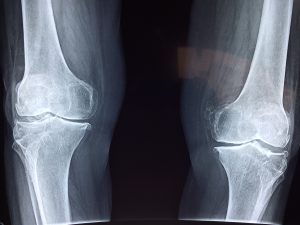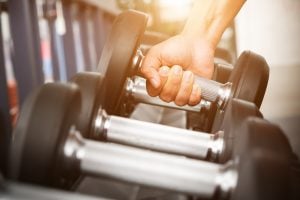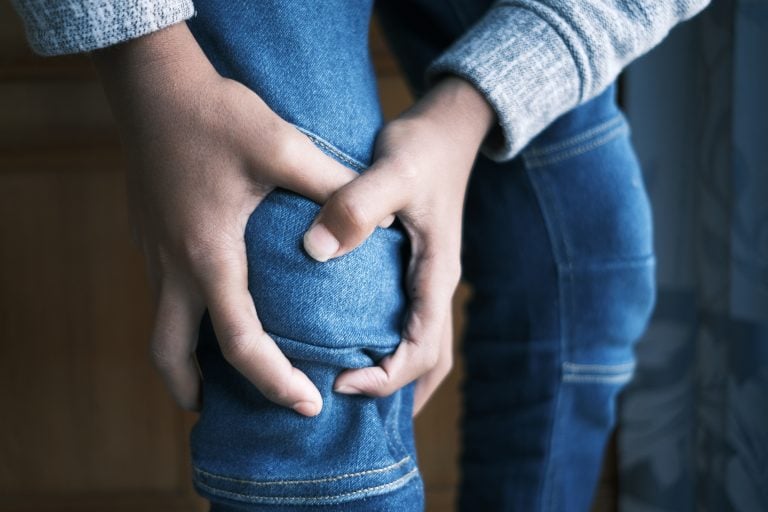As we get older, the natural cycle of bone renewal begins to shift. Our bodies break down bone faster than they can rebuild it. Over time, this imbalance causes bones to lose density and become thinner, weaker, and more fragile. The result is a significantly higher risk of fractures, even from everyday activities.
Osteoporosis, a disease that weakens bones and makes them more likely to break, affects an estimated 10 million U.S. adults over 50. The vast majority are women. Another 43 million are living with low bone mass, an insidious condition that increases the risk of osteoporosis.1Wright NC, Looker AC, Saag KG, et al. The recent prevalence of osteoporosis and low bone mass in the United States based on bone mineral density at the femoral neck or lumbar spine. J Bone Miner Res. 2014;29(11):2520-2526. https://pmc.ncbi.nlm.nih.gov/articles/PMC4757905 As the aging population continues to expand, experts anticipate a sharp increase in the number of fractures caused by bone fragility.2Porter JL, Varacallo MA. Osteoporosis. In: StatPearls. StatPearls Publishing; 2025. Accessed April 29, 2025. http://www.ncbi.nlm.nih.gov/books/NBK441901
When bone loss is identified early, steps can be taken to slow or even stop its progression. The right combination of lifestyle changes, medical treatment, and monitoring can help preserve bone health and significantly reduce the risk of fractures later in life. Early action could mean the difference between long-term independence and a serious, potentially life-altering injury.
What causes primary and secondary osteoporosis?
Up until our 30s, we build more bone than we break down. This balance helps keep bones strong and dense. But by our 40s, the equation changes. We begin to lose bone faster than it can be replaced. Aging also disrupts hormone levels, which can diminish bone mineral density and further weaken skeletal structure.2Porter JL, Varacallo MA. Osteoporosis. In: StatPearls. StatPearls Publishing; 2025. Accessed April 29, 2025. http://www.ncbi.nlm.nih.gov/books/NBK441901
Primary osteoporosis is divided into two types. Type 1, or postmenopausal osteoporosis, is triggered by hormonal changes during menopause. Estrogen and progesterone play a key role in maintaining bone health by regulating the cycle of bone formation and reabsorption. When estrogen levels drop, this cycle falters, leading to accelerated bone loss and a higher risk of fractures. Type 1 osteoporosis is most common 10 to 15 years after menopause, typically between ages 50 and 70.3Keen MU, Reddivari AKR. Osteoporosis in females. In: StatPearls. StatPearls Publishing; 2025. Accessed April 29, 2025. http://www.ncbi.nlm.nih.gov/books/NBK559156
Type 2 osteoporosis is primarily associated with calcium depletion and other age-related health issues. It’s a leading cause of hip fractures in older women.1Wright NC, Looker AC, Saag KG, et al. The recent prevalence of osteoporosis and low bone mass in the United States based on bone mineral density at the femoral neck or lumbar spine. J Bone Miner Res. 2014;29(11):2520-2526. https://pmc.ncbi.nlm.nih.gov/articles/PMC4757905,3Keen MU, Reddivari AKR. Osteoporosis in females. In: StatPearls. StatPearls Publishing; 2025. Accessed April 29, 2025. http://www.ncbi.nlm.nih.gov/books/NBK559156
Secondary osteoporosis has different origins. It’s more common in men and results from chronic diseases or medications that interfere with bone health.
Several health conditions are also linked to bone loss and low bone mineral density2Porter JL, Varacallo MA. Osteoporosis. In: StatPearls. StatPearls Publishing; 2025. Accessed April 29, 2025. http://www.ncbi.nlm.nih.gov/books/NBK441901,3Keen MU, Reddivari AKR. Osteoporosis in females. In: StatPearls. StatPearls Publishing; 2025. Accessed April 29, 2025. http://www.ncbi.nlm.nih.gov/books/NBK559156:
- Hyperparathyroidism and hyperthyroidism
- Anorexia
- Diabetes
- Digestive absorption issues
- Chronic kidney disease
- Celiac disease
- Autoimmune disorders, like rheumatoid arthritis
For women, missing periods for more than a year, whether due to perimenopause, eating disorders, or extreme exercise, can lead to rapid declines in bone density. Certain medications may also contribute to bone loss. These include anti-epileptic drugs, aluminum-containing antacids, heparin (a blood thinner), thyroxine (a hyperthyroidism treatment), and corticosteroids.2Porter JL, Varacallo MA. Osteoporosis. In: StatPearls. StatPearls Publishing; 2025. Accessed April 29, 2025. http://www.ncbi.nlm.nih.gov/books/NBK441901,3Keen MU, Reddivari AKR. Osteoporosis in females. In: StatPearls. StatPearls Publishing; 2025. Accessed April 29, 2025. http://www.ncbi.nlm.nih.gov/books/NBK559156
Who is most at risk for osteoporosis?

Some risk factors for osteoporosis are beyond our control. Age, family history, sex, ethnicity, early menopause, and a history of adult fractures all increase susceptibility.2Porter JL, Varacallo MA. Osteoporosis. In: StatPearls. StatPearls Publishing; 2025. Accessed April 29, 2025. http://www.ncbi.nlm.nih.gov/books/NBK441901,3Keen MU, Reddivari AKR. Osteoporosis in females. In: StatPearls. StatPearls Publishing; 2025. Accessed April 29, 2025. http://www.ncbi.nlm.nih.gov/books/NBK559156 But many factors are modifiable:
- Smoking
- Excessive alcohol consumption
- Low or very high body weight
- Chronically low calcium levels
- Missed menstrual periods (for more than one year)
- Frequent falls
- Lack of weight-bearing exercise
Any condition that significantly limits movement or mobility can also affect bone health. Just two weeks of reduced activity due to injury or illness could cause a rapid decline in bone mineral density.2Porter JL, Varacallo MA. Osteoporosis. In: StatPearls. StatPearls Publishing; 2025. Accessed April 29, 2025. http://www.ncbi.nlm.nih.gov/books/NBK441901
Long-term use of oral corticosteroids is another major contributor to osteoporosis. These medications deplete calcium and weaken bone tissue.3Keen MU, Reddivari AKR. Osteoporosis in females. In: StatPearls. StatPearls Publishing; 2025. Accessed April 29, 2025. http://www.ncbi.nlm.nih.gov/books/NBK559156 Estrogen blockers, such as aromatase inhibitors used in breast cancer treatment, also increase fracture risk. Studies show that women taking antiestrogen drugs have a higher likelihood of spinal and other fractures over time.4Lee YK, Lee EG, Kim HY, et al. Osteoporotic fractures of the spine, hip, and other locations after adjuvant endocrine therapy with aromatase inhibitors in breast cancer patients: a meta-analysis. J Korean Med Sci. 2020 Nov 30;35(46):e403. https://doi.org/10.3346/jkms.2020.35.e403
Osteoporosis symptoms and fractures
Osteoporosis is often called a “silent disease” because bone loss occurs gradually and without apparent symptoms. Some people may experience mild bone pain, especially in the hips or feet, but many don’t realize anything is wrong until a fracture occurs. Early screening for osteoporosis can play a crucial role in preventing significant injury.2Porter JL, Varacallo MA. Osteoporosis. In: StatPearls. StatPearls Publishing; 2025. Accessed April 29, 2025. http://www.ncbi.nlm.nih.gov/books/NBK441901
Fractures are the most serious consequence of osteoporosis. Hip fractures, in particular, often require surgery, lengthy hospital stays, and ongoing rehabilitation. They can lead to lasting disability and even increased risk of death. Only about 33 percent of senior women who experience a hip fracture are able to return to independent living. Worse still, one hip fracture significantly raises the risk of having another.
Spinal fractures can happen with or without a fall and are often followed by chronic back pain, reduced mobility, and noticeable changes in posture.2Porter JL, Varacallo MA. Osteoporosis. In: StatPearls. StatPearls Publishing; 2025. Accessed April 29, 2025. http://www.ncbi.nlm.nih.gov/books/NBK441901
There are seven fundamental risk factors for osteoporotic fractures2Porter JL, Varacallo MA. Osteoporosis. In: StatPearls. StatPearls Publishing; 2025. Accessed April 29, 2025. http://www.ncbi.nlm.nih.gov/books/NBK441901:
- Older age
- Previous adult fracture
- Sex (women are at greater risk)
- Corticosteroid use
- Low body weight
- Smoking
- Alcohol use
Strengthening bones naturally

Whether boosting skeletal health through food or supplements, the goal is to increase high-quality protein, good fats, calcium, magnesium, vitamin D, and other bone-building minerals.
Calcium is the most vital mineral for healthy bones. Recommended daily calcium amounts are 1,200 mg for young adults, 1,000 mg for women ages 25 to 50, and 1,500 mg for postmenopausal women. Aside from dairy, calcium-rich foods include leafy green vegetables, almonds, salmon, seafood, legumes, and tofu.5Martiniakova M, Babikova M, Mondockova V, Blahova J, Kovacova V, Omelka R. The role of macronutrients, micronutrients and flavonoid polyphenols in the prevention and treatment of osteoporosis. Nutrients. 2022;14(3):523. https://pmc.ncbi.nlm.nih.gov/articles/PMC8839902
Increasing calcium intake doesn’t guarantee proper absorption. The body tends to absorb less calcium with age, and lower levels of vitamin D (which promotes calcium absorption) also factor in. Taken together, calcium and vitamin D reduce the general risk of fractures by up to 15 percent. For hip fractures, this combination could cut risk by up to 30 percent.6Rizzoli R, Chevalley T. Nutrition and osteoporosis prevention. Curr Osteoporos Rep. 2024;22(6):515-522. https://pmc.ncbi.nlm.nih.gov/articles/PMC11499541 Taking 800 IU of vitamin D3 and 1,200 mg of calcium daily reduces hip and non-spinal fractures in people over 65.7Manoj P, Derwin R, George S. What is the impact of daily oral supplementation of vitamin D3 (cholecalciferol) plus calcium on the incidence of hip fracture in older people? A systematic review and meta-analysis. Int J Older People Nurs. 2023;18(1):e12492. https://pmc.ncbi.nlm.nih.gov/articles/PMC10078370
Magnesium supports vitamin D absorption, which, in turn, boosts calcium absorption. Research shows that low magnesium levels significantly increase fracture risk, suggesting that calcium, vitamin D, and magnesium form a strong bone-building team.7Manoj P, Derwin R, George S. What is the impact of daily oral supplementation of vitamin D3 (cholecalciferol) plus calcium on the incidence of hip fracture in older people? A systematic review and meta-analysis. Int J Older People Nurs. 2023;18(1):e12492. https://pmc.ncbi.nlm.nih.gov/articles/PMC10078370,8Groenendijk I, van Delft M, Versloot P, van Loon LJC, de Groot LCPGM. Impact of magnesium on bone health in older adults: A systematic review and meta-analysis. Bone. 2022 Jan;154:116233. https://doi.org/10.1016/j.bone.2021.116233 Vitamin K is another essential nutrient, with research supporting a calcium and vitamin K regimen for strengthening bones in the lower back.9Dominguez LJ, Veronese N, Ciriminna S, et al. Association between serum magnesium and fractures: a systematic review and meta-analysis of observational studies. Nutrients. 2023 Mar 7;15(6):1304. https://doi.org/10.3390/nu15061304,10Hu L, Ji J, Li D, Meng J, Yu B. The combined effect of vitamin K and calcium on bone mineral density in humans: a meta-analysis of randomized controlled trials. J Orthop Surg Res. 2021 Oct 14;16(1):592. https://doi.org/10.1186/s13018-021-02728-4
Dietary strategies for reducing osteoporosis risk

Instead of focusing solely on individual nutrients, consider broader dietary patterns, which may be a more effective strategy for protecting bone health. The way foods interact can be just as important as their separate components.
The Mediterranean Diet has been shown to reduce inflammation, help manage weight, and lower blood pressure and cholesterol levels, all of which protect against osteoporosis. Plant-based foods and healthy fats are the foundation of the Mediterranean Diet, which has four basic components:
- Fruits and vegetables provide an abundance of vitamins, minerals, and antioxidants.
- Fish and nuts are excellent sources of omega–3 fatty acids.
- Dairy products supply essential calcium and vitamin D.
- Olive oil is known for its high polyphenol content.
Research confirms that this diet is especially beneficial for menopausal and postmenopausal women, the two groups most susceptible to osteoporosis.
Vegan and vegetarian diets, which tend to be lower in calcium and vitamin D, are linked to higher osteoporosis risk. Vegetarians face a 1.3–fold greater chance of hip fracture compared with omnivores.6Rizzoli R, Chevalley T. Nutrition and osteoporosis prevention. Curr Osteoporos Rep. 2024;22(6):515-522. https://pmc.ncbi.nlm.nih.gov/articles/PMC11499541
Fiber and the microbiome
High-fiber foods nourish beneficial gut bacteria. Inulin (a type of prebiotic fiber) can increase calcium absorption by 58 percent in young adults and 42 percent in postmenopausal women.5Martiniakova M, Babikova M, Mondockova V, Blahova J, Kovacova V, Omelka R. The role of macronutrients, micronutrients and flavonoid polyphenols in the prevention and treatment of osteoporosis. Nutrients. 2022;14(3):523. https://pmc.ncbi.nlm.nih.gov/articles/PMC8839902
Healthy fats

Saturated fatty acids (also called “bad fats”) can weaken bones and heighten the risk of fractures, particularly in the hips. In contrast, monounsaturated fats may strengthen bones, especially in the wrist. Olive oil, high in vitamin E and phenols, is linked to improved lower spine strength in women.
Fish is an excellent source of polyunsaturated fats, which also support bone density. Increasing fish consumption, or supplementing with fish oil containing four percent concentrated omega–3s, has been shown to strengthen bones and reduce fracture risk in women.5Martiniakova M, Babikova M, Mondockova V, Blahova J, Kovacova V, Omelka R. The role of macronutrients, micronutrients and flavonoid polyphenols in the prevention and treatment of osteoporosis. Nutrients. 2022;14(3):523. https://pmc.ncbi.nlm.nih.gov/articles/PMC8839902
Protein
Protein, which composes 30 percent of bone mass and 50 percent of bone volume,5Martiniakova M, Babikova M, Mondockova V, Blahova J, Kovacova V, Omelka R. The role of macronutrients, micronutrients and flavonoid polyphenols in the prevention and treatment of osteoporosis. Nutrients. 2022;14(3):523. https://pmc.ncbi.nlm.nih.gov/articles/PMC8839902 is foundational for bone structure, strength, and mineralization.
Eating more protein could reduce the risk of hip fracture, especially when paired with calcium. One study found that people who consumed 800 mg of calcium per day while increasing their protein intake saw a marked reduction in hip fractures. However, these benefits were absent in those with low calcium levels.11Sahni S, Cupples LA, McLean RR, et al. Protective effect of high protein and calcium intake on the risk of hip fracture in the Framingham offspring cohort. J Bone Miner Res. 2010 Dec;25(12):2770-6. https://doi.org/10.1002/jbmr.194
Another study showed that 20 grams of supplemental protein taken daily for six months, along with sufficient vitamin D and calcium, significantly preserved bone mineral density in the hips.6Rizzoli R, Chevalley T. Nutrition and osteoporosis prevention. Curr Osteoporos Rep. 2024;22(6):515-522. https://pmc.ncbi.nlm.nih.gov/articles/PMC11499541
Dairy products
Increased fracture risk among vegans can often be traced to a lack of dairy. A single liter of milk provides up to 35 grams of protein, 1,200 mg of calcium, and 930 mg of phosphorus, plus essential trace elements and vitamins.
Fermented dairy products like yogurt and cheese may be especially protective. Just 200 grams of yogurt or 20 grams of cheese can lower hip fracture risk by up to 15 percent. Yogurt alone has been shown to reduce the risk of lower hip fractures by 24 percent.6Rizzoli R, Chevalley T. Nutrition and osteoporosis prevention. Curr Osteoporos Rep. 2024;22(6):515-522. https://pmc.ncbi.nlm.nih.gov/articles/PMC11499541
Beverages and tea
What you drink matters too. Green tea, in particular, contains high levels of flavonoids and polyphenols, which are known to support bone strength and density.6Rizzoli R, Chevalley T. Nutrition and osteoporosis prevention. Curr Osteoporos Rep. 2024;22(6):515-522. https://pmc.ncbi.nlm.nih.gov/articles/PMC11499541 Sugar-sweetened beverages, especially soda, can weaken bones over time.
Exercising to prevent osteoporosis

Resistance and weight-bearing exercises stimulate bone growth. The most effective routine for preventing osteoporosis incorporates cardiovascular activity (walking, jogging, climbing stairs), strength building, and balance training.2Porter JL, Varacallo MA. Osteoporosis. In: StatPearls. StatPearls Publishing; 2025. Accessed April 29, 2025. http://www.ncbi.nlm.nih.gov/books/NBK441901 Exercises that target the legs are especially beneficial for hip strength.3Keen MU, Reddivari AKR. Osteoporosis in females. In: StatPearls. StatPearls Publishing; 2025. Accessed April 29, 2025. http://www.ncbi.nlm.nih.gov/books/NBK559156
Exercising for 30 minutes, three to four times per week, can boost bone mineral density. For older women with osteoporosis, a well-rounded workout mixing strength, aerobics, balance, and flexibility training helps reduce fall risk. Aim for two to three 45-minute sessions a week for optimal results.
A recent study found that tai chi is the most effective traditional Chinese exercise for postmenopausal women. Regular practice can improve muscle and bone strength, enhance balance and flexibility, and lower fracture risk in the hips and lower spine.12Liu X, Jiang C, Fan R, et al. The effect and safety of tai chi on bone health in postmenopausal women: a meta-analysis and trial sequential analysis. Front Aging Neurosci. 2022 Sep 13;14:935326. https://doi.org/10.3389/fnagi.2022
Footnotes
- 1Wright NC, Looker AC, Saag KG, et al. The recent prevalence of osteoporosis and low bone mass in the United States based on bone mineral density at the femoral neck or lumbar spine. J Bone Miner Res. 2014;29(11):2520-2526. https://pmc.ncbi.nlm.nih.gov/articles/PMC4757905
- 2Porter JL, Varacallo MA. Osteoporosis. In: StatPearls. StatPearls Publishing; 2025. Accessed April 29, 2025. http://www.ncbi.nlm.nih.gov/books/NBK441901
- 3Keen MU, Reddivari AKR. Osteoporosis in females. In: StatPearls. StatPearls Publishing; 2025. Accessed April 29, 2025. http://www.ncbi.nlm.nih.gov/books/NBK559156
- 4Lee YK, Lee EG, Kim HY, et al. Osteoporotic fractures of the spine, hip, and other locations after adjuvant endocrine therapy with aromatase inhibitors in breast cancer patients: a meta-analysis. J Korean Med Sci. 2020 Nov 30;35(46):e403. https://doi.org/10.3346/jkms.2020.35.e403
- 5Martiniakova M, Babikova M, Mondockova V, Blahova J, Kovacova V, Omelka R. The role of macronutrients, micronutrients and flavonoid polyphenols in the prevention and treatment of osteoporosis. Nutrients. 2022;14(3):523. https://pmc.ncbi.nlm.nih.gov/articles/PMC8839902
- 6Rizzoli R, Chevalley T. Nutrition and osteoporosis prevention. Curr Osteoporos Rep. 2024;22(6):515-522. https://pmc.ncbi.nlm.nih.gov/articles/PMC11499541
- 7Manoj P, Derwin R, George S. What is the impact of daily oral supplementation of vitamin D3 (cholecalciferol) plus calcium on the incidence of hip fracture in older people? A systematic review and meta-analysis. Int J Older People Nurs. 2023;18(1):e12492. https://pmc.ncbi.nlm.nih.gov/articles/PMC10078370
- 8Groenendijk I, van Delft M, Versloot P, van Loon LJC, de Groot LCPGM. Impact of magnesium on bone health in older adults: A systematic review and meta-analysis. Bone. 2022 Jan;154:116233. https://doi.org/10.1016/j.bone.2021.116233
- 9Dominguez LJ, Veronese N, Ciriminna S, et al. Association between serum magnesium and fractures: a systematic review and meta-analysis of observational studies. Nutrients. 2023 Mar 7;15(6):1304. https://doi.org/10.3390/nu15061304
- 10Hu L, Ji J, Li D, Meng J, Yu B. The combined effect of vitamin K and calcium on bone mineral density in humans: a meta-analysis of randomized controlled trials. J Orthop Surg Res. 2021 Oct 14;16(1):592. https://doi.org/10.1186/s13018-021-02728-4
- 11Sahni S, Cupples LA, McLean RR, et al. Protective effect of high protein and calcium intake on the risk of hip fracture in the Framingham offspring cohort. J Bone Miner Res. 2010 Dec;25(12):2770-6. https://doi.org/10.1002/jbmr.194
- 12Liu X, Jiang C, Fan R, et al. The effect and safety of tai chi on bone health in postmenopausal women: a meta-analysis and trial sequential analysis. Front Aging Neurosci. 2022 Sep 13;14:935326. https://doi.org/10.3389/fnagi.2022





